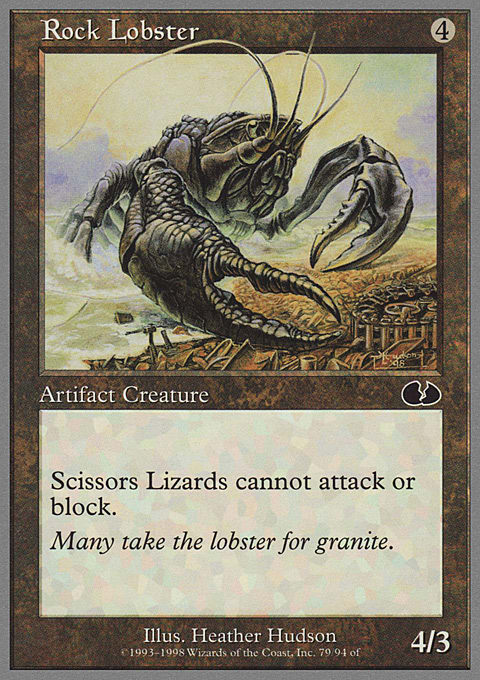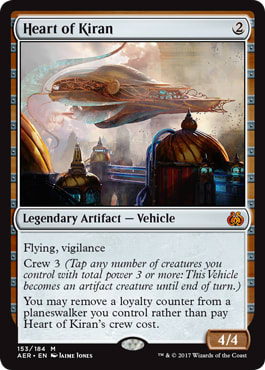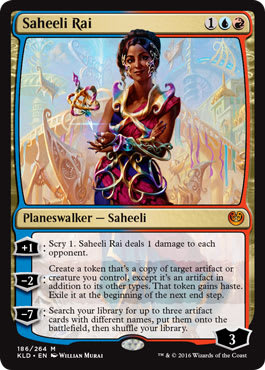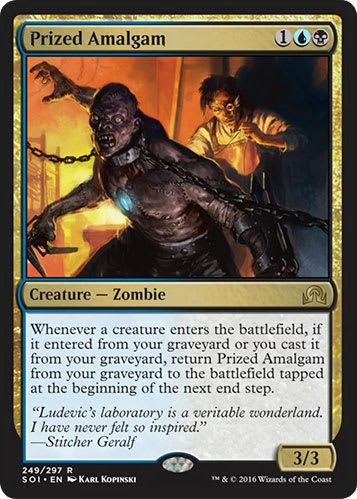- Mardu (RWB) Vehicle
- BG Constrictor
- Jeskai (UWR) Saheeli
It’s apparent at this point that these are the decks to beat.
On the surface, this appears to be your quintessential Rock-Paper-Scissors metagame. Vehicles beats Saheeli, Constrictor beats Vehicles, and Saheeli beats Constrictor. With this information, the logical conclusion would be to play the deck that beats the one you expect to be the most popular. There’s a glaring flaw in this line of thought though; Magic is not, in fact, Rock-Paper-Scissors. I know I’m just stating the obvious, but it’s important to make the distinction, for this line of thinking is one of the most common mistakes people make in deck selection. There’s countless other things to consider when determining which deck gives you the best chance of doing well in a tournament.
And while I know no one takes the analogy literally, it is this oversimplification that often leads to misconceptions in how to attack a metagame. So rather than just leaving it at an oversimplification, I’m going to break down exactly what you need to know when selecting a deck in a Rock-Paper-Scissors metagame.
Leveling
This is where the two are the most similar, and it’s likely what invites the comparison in the first place. Leveling is present in both Rock-Paper-Scissors and Magic. You can choose rock, paper or scissors, or you can choose a level 1, level 0 or level 2 deck. The only notable difference is the fact that you’re making an informed decision in Magic. There’s no shortage of information that you can use to determine an expected metagame.
I’m writing this prior to Grand Prix Pittsburgh, so I don’t know what the metagame actually looked like, but the obvious deck to beat going into the tournament is Mardu Vehicles. Using this information it would easy to determine that B/G Constrictor is a good choice for the tournament. This is where metagaming stops for most people, but there is significantly more to it than this.
There Are No 100% Matchups
Paper always beats rock. No matter how many times you insist how ridiculous it is that paper can beat a rock, there’s no way around it. This is far from the case in Magic. Quantifying matchup percentages in Magic isn’t an exact science, but it’s pretty rare for anything to really be over 60%. You can be unfavored in a certain matchup, yet still win every match against it in a tournament. Obviously this is much easier to do when the matchup is close, and much more difficult to do when the matchup is lopsided. There’s two ways you can use this information in deck selection; you can identify which deck has the closest matchups against the other two, or you can you can play the deck with the most lopsided matchup and hope pairings break your way. The latter option may sound a bit asinine in comparison to the former, but in reality it’s generally the option that gives you the best chance of coming in actual 1st. The downside is you’re significantly more likely to miss Day 2.
Most players will tend to gravitate toward the deck with best matchups across the board though, especially if they’re confident in their play skill. This is the reason Mardu Vehicles was the most popular deck at the Pro Tour. Vehicles is a heavy favorite against Saheeli, and only a slight dog to Constrictor. If Vehicles wins the die roll, it’s not even clear if they’re actually unfavored at that point.
Understanding this is a pivotal component of deck selection as it not only gives you a good idea about what decks people might play, but also how they’re built. Jeskai Saheeli versus B/G Constrictor is the most lopsided matchup among the three decks with Saheeli being a clear favorite. If Mardu Vehicles is the deck to beat, then it would stand to reason that the majority of Constrictor players are going to gear their deck toward beating Vehicles while sacrificing percentage points against Saheeli in the process. This can be deduced because unlike Vehicles, Constrictor isn’t capable of competing on an even playing field with the other two at the same time. You can construct the deck to either beat vehicles consistently, or you can attempt close the gap in the Jeskai matchup. Since Vehicles is likely to be far more popular than Jeskai, it’s safe to assume that the majority of Constrictor lists will be skewed towards beating Vehicles.
A Mirror isn’t a Draw
Any jokes about Miracle mirrors aside, a mirror match isn’t a draw. In fact, it’s normally one of the matchups you stand to gain the most percentage points in just by adding a few cards. Preparing for the mirror is perhaps more important than any other matchup. Assuming you used any sort of Logic in selecting your deck, it’s easy to assume that others may draw the same conclusions as you and the deck may end up being a fairly popular choice. It’s also important because every adjustment you make with the mirror in mind shifts the matchup in your favor. If two people were to show up with Lucas Esper Berthoud’s 75 from the Pro Tour, they would have a 50/50 matchup against each other. If one of them were to play Fatal Push instead of shock, they increase their probability of winning the match. It wouldn’t be by any drastic margins, but in a game that’s essentially all about sample size I wouldn’t consider it a negligible amount either.
Some mirror matches offer significantly more room to gain an edge than others though, and being able to identify this is critical. Going back to the current metagame, this is the reason why I would expect many players who piloted Mardu Vehicles at the Pro Tour to bring something else to the table in Pittsburgh. I mentioned that the Constrictor decks can’t realistically beat Vehicles and Jeskai simultaneously, but the deck can be built to beat Vehicles while trying to gain an edge in the mirror. This is something that Mardu doesn’t really have going for it. The core of the deck is too tight, and the games are too fast and volatile, so there’s a real limit to how prepared you can be for the mirror without costing your other matchups too much.
There’s More Than Three Options
Standard isn’t always the most diverse format. With such a small card pool available, the most powerful cards will often rise to the top and dictate what is and what isn’t playable in the format. With that being said, there will be always be viable options outside of the best three decks. These decks normally tend to be weaker or inconsistent, but they’re the decks you’re often afraid of running into in a tournament. It’s unlikely you’re showing up to a tournament with the plan of completely dodging one of the most prevalent decks, but that’s often the case here.
The best way to prepare for the more fringe decks in the format is to employ a powerful proactive strategy. These decks are normally fringe for a reason, and as I mentioned it’s normally due to low a power level or consistency issues. Proactive strategies do a great job at exploiting both of these flaws. If the deck is relatively weak, it’s easy to just run over them. If the deck is inconsistent, you can punish them for stumbling.
Before the Pro Tour, the deck I was testing the most was B/R Zombies. I was pretty impressed with the deck, and it seemed to have game against everything. The combo of Lightning Axe/ Fiery Temper was great against Vehicles, Voldaren Pariah was devastating against B/G, and plethora of removal spells plus the entire zombie engine felt absurd against Jeskai. The problem with the deck is it loses to itself too often. Then mana is shaky, Prized Amalgams often rot in your hand, and the deck just doesn’t really do anything if there are no Amalgams in your top 15-20 cards.
So is it ever right to attack the Rock-Paper-Scissors metagame from the outside with a deck like this?
Absolutely. It will be a poor choice more often than not, but it’s all about giving yourself the best chance to win. If the deck lines up well enough against the field, it can certainly merit the risk.
Predictions
This is the part where I give my article some credibility, and I look like a genius. Or it’s the part where look like an idiot who spent way too long pointing out the obvious differences Rock-Paper-Scissors and Magic: The Gathering. I’m writing this on the Friday morning prior to Grand Prix Pittsburgh, so I have no idea what was actually played in the invent. Applying the points in my article, I’m going to predict what decks I expect players to show up with, which decks will perform well, and what the lists might look like.
- B/G Constrictor will be the most played deck by a fairly large marge margin, followed by Mardu Vehicles.
- The B/G decks that do well will resemble Brad Nelson’s from the PT. They’ll have have four Fatal Push main, multiple copies of Aethersphere Harvester, the copies of Gonti, Lord of Luxury will be moved to the sideboard, and they’ll trim number of Lifecrafter's Bestiary in the sideboard.
- The Mardu Vehicle lists that perform well will play Fatal Push over Shock in the maindeck. Despite the 1st and 2nd place finishers from the PT omitting Blue from their lists, the majority of lists that perform well will still feature the splash for Metallic Rebuke.
- The Top 8 will contain 4 B/G decks, 1 Vehicle decks, 1 Jeskai Saheeli deck, 1 Four-Color Saheeli deck, and 1 Prized Amalgam deck.
- Prized Amalgam decks will remain fringe despite a solid finish, and a few high profile players piloting the deck.
- One of the Top 8 GB players will be a person that played Mardu Vehicles in the Pro Tour.
- The one copy of Jeskai Saheeli in the Top 8 will win the tournament.
Thanks for reading, and look forward to my next article, “Grass is Green”.






























